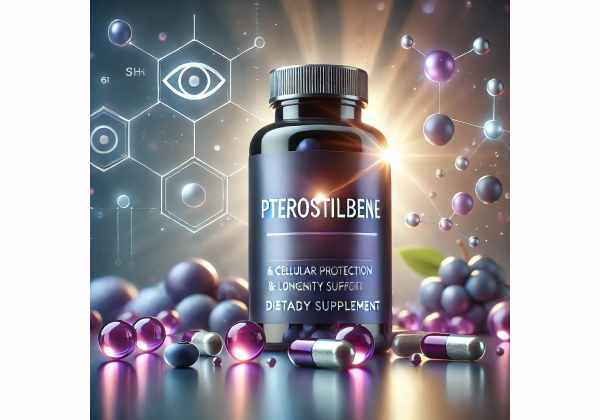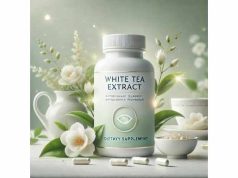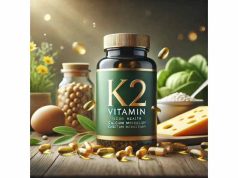
Pterostilbene—a naturally occurring compound found in certain berries and nuts—is quickly gaining recognition for its antioxidant and anti-inflammatory properties. While most discussions center around its potential benefits for cognitive function and cardiovascular wellness, emerging research also highlights its promising role in supporting eye health. By helping to shield delicate ocular tissues from oxidative damage, improving blood flow, and potentially influencing healthy glucose metabolism, Pterostilbene may aid in preserving optimal vision. In this comprehensive article, we explore its defining characteristics, how it might improve visual function, and the ways you can integrate it into your routine to sustain clearer, more comfortable eyesight over the long term.
Table of Contents
- Pterostilbene Explained: Sources and Characteristics
- Pathways Through Which Pterostilbene Enriches Vision
- Major Benefits of Pterostilbene for Eye Health
- Practical Methods to Use Pterostilbene Effectively
- Scientific Insights and Research Developments
- Frequently Asked Questions About Pterostilbene
- References and Sources
Pterostilbene Explained: Sources and Characteristics
Pterostilbene is a methylated stilbene molecule structurally similar to resveratrol. However, its slightly different composition confers higher bioavailability and stability, potentially making it more effective in certain scenarios. While it’s commonly linked to blueberries, researchers have identified other natural sources such as grapes and certain tree barks. Interest in Pterostilbene has escalated due to findings suggesting it might counteract cellular aging, protect neurological health, and positively modulate metabolic pathways.
Historical Background
- Traditional Observations: Folk remedies have long lauded berry consumption for supporting general longevity.
- Modern Discovery: As scientists investigated resveratrol in red wine and grapes, they identified Pterostilbene as a related but distinct compound. Over the last decade, a surge in laboratory and clinical explorations has put it on the radar of nutrition and wellness communities.
Chemical Stability
Compared to resveratrol, Pterostilbene has two methoxy groups instead of hydroxyl groups, enhancing its resistance to metabolism and giving it a longer half-life in the body. This superior stability partly explains why smaller dosages may yield comparable or stronger effects than those typically observed with resveratrol.
Key Biological Properties
- Antioxidant Action: Pterostilbene neutralizes harmful free radicals, mitigating oxidative stress.
- Anti-Inflammatory Effects: Laboratory tests show it can reduce certain inflammatory markers, an essential factor in maintaining tissues prone to daily wear, such as the eyes.
- Potential Glucose Regulation: Studies indicate it may help support healthy blood sugar levels—crucial, as unregulated glucose can endanger retinal vessels and corneal integrity.
- Neuroprotective Capacities: Because the optic nerve is part of the central nervous system, Pterostilbene’s neuro-supportive features could extend to ocular structures.
While still under extensive review, early data points to strong potential for Pterostilbene to bolster Eye Health by safeguarding cells from age-accelerating stressors and fostering a less inflammatory biological environment. As we delve deeper, it becomes clear why this compound is of great interest to those who prioritize maintaining sharp vision over a lifetime.
Pathways Through Which Pterostilbene Enriches Vision
Vision depends on countless interconnected processes within the eyes—requiring ample antioxidant support, balanced inflammatory responses, and efficient nutrient delivery. Pterostilbene capitalizes on these critical elements to help preserve sight, especially in the face of aging or heavy screen use.
1. Shields the Retina from Oxidative Stress
The retina’s photoreceptor cells are energy-intensive, rendering them vulnerable to oxidative damage. Harmful radicals generated by UV rays or everyday metabolic activity can degrade rods and cones over time, leading to progressive vision loss. Pterostilbene’s strong antioxidant profile helps neutralize these radicals, potentially slowing or preventing related harm.
2. Supports Microcirculation Around the Eyes
Healthy circulation underlies eye function, delivering oxygen and nutrients to the retina while carrying away waste products. By modulating endothelial function and promoting nitric oxide release, Pterostilbene may slightly improve microvascular health. This fortification could be especially beneficial for individuals with borderline vascular issues, enhancing nutrient flow where needed.
3. Calms Systemic Inflammation
Chronic, low-level inflammation is a known driver of ocular disorders like age-related macular degeneration (AMD), diabetic retinopathy, and chronic dry eye. Substances that curb inflammatory cytokines can indirectly protect ocular tissues. Early data underscores Pterostilbene’s ability to dampen pro-inflammatory pathways, reducing the likelihood or pace of degenerative changes.
4. Potential Defense Against Glycation
Excessive sugar binding to proteins, or glycation, compromises lens clarity and accelerates age-related changes in the eye. Preliminary studies suggest that Pterostilbene can help regulate glucose metabolism, thus lowering glycation risks. Consequently, lens proteins remain more stable and flexible, warding off early cataract formation.
5. Neuroprotective Effects for the Optic Nerve
The optic nerve transmits visual signals from the retina to the brain. Because Pterostilbene’s compounds exhibit neuroprotective qualities, they might safeguard the optic nerve’s integrity, fending off conditions such as glaucoma, where high intraocular pressure damages nerve fibers. While this theory warrants deeper clinical validation, animal tests are encouraging.
6. Synergy with Other Eye-Friendly Nutrients
Within the body, synergy reigns. Pterostilbene likely amplifies the benefits of established eye-supportive nutrients like lutein, zeaxanthin, and vitamin C. By reinforcing the antioxidant network, the compound ensures all elements function more potently—creating a comprehensive line of defense for the lens, retina, and other sensitive structures.
By engaging these pathways, Pterostilbene may play a multifaceted role in preserving visual acuity. It broadens the standard approach to Eye Health beyond mere vitamins, delving into deeper mechanisms like inflammation and vascular regulation, both of which are pivotal to how well and how long our eyes function.
Major Benefits of Pterostilbene for Eye Health
While Pterostilbene is not a silver bullet that replaces routine eye exams or proven medical treatments, its unique properties may offer an additional layer of protection. Below are some principal reasons people gravitate toward Pterostilbene for Vision Benefits:
1. Minimizing Digital Eye Strain
In modern life, extended screen time triggers dryness, irritation, and general ocular fatigue. By reducing inflammation and boosting antioxidant defenses, Pterostilbene helps eyes adapt to prolonged focus on digital displays. This advantage also complements best practices like the 20-20-20 rule or blue-light filtering lenses.
2. Contributing to Glaucoma Prevention
Glaucoma stems from elevated intraocular pressure damaging the optic nerve. While Pterostilbene doesn’t directly lower pressure, it may reinforce neuronal and vascular integrity, buffering the optic nerve against degenerative damage. Combined with standard ophthalmic guidance, these effects may help preserve vision among at-risk individuals.
3. Slowing Cataract Progression
Oxidative stress and glycation are implicated heavily in cataract formation. Given Pterostilbene’s synergy in regulating blood sugar and its antioxidant potency, it could help maintain lens clarity longer. Though not a cure for advanced cataracts, it can support strategies for mitigating early-stage changes.
4. Enhancing Night Vision and Light Adaptation
Retinal photoreceptors rely on robust nutrient supply and minimal oxidative damage to handle rapid light shifts (e.g., moving from a bright room to nighttime outdoors). By reinforcing the retina’s antioxidant environment, Pterostilbene might help these cells respond more quickly and function better in low-light or high-glare situations.
5. Helping Stabilize Diabetic Eye Concerns
Diabetic retinopathy arises from damaged retinal blood vessels due to high blood sugar. Pterostilbene’s potential to encourage healthy glucose metabolism can contribute to improved microvascular protection, giving the retina a better chance to stay healthy in diabetic or prediabetic conditions—though medical oversight is always essential.
6. Promoting Overall Retinal Health
The retina is often described as an extension of the brain, underscoring its reliance on anti-inflammatory and neuroprotective support. Pterostilbene’s combined capacity to quell inflammation, neutralize radicals, and modulate neurotransmitter activity might keep retinal cells more resilient, preserving sharper vision over time.
7. Contributing to a Balanced Lifestyle
Many individuals leverage Pterostilbene not just for their eyes but for improved metabolic or cognitive health. With its wide-ranging benefits, including potential cholesterol and triglyceride management, the supplement can fit neatly into holistic well-being strategies that simultaneously bolster eye function.
In essence, Pterostilbene for Eye Health stands as a versatile agent capable of enhancing multiple facets of ocular protection. While it thrives best in conjunction with other beneficial compounds, its capacity to address root causes (like oxidation and sugar dysregulation) makes it a compelling addition for those seeking to maintain good eyesight.
Practical Methods to Use Pterostilbene Effectively
Adding Pterostilbene to your daily routine can be straightforward, but understanding dosage, timing, and synergy with other nutrients can ensure you extract its maximum potential for vision improvement.
1. Selecting a Quality Supplement
- Standardized Concentration: Look for supplements specifying the milligram (mg) content of Pterostilbene per serving.
- Reputable Brands: Third-party certifications can help verify purity and potency.
- Blends: Some formulas combine Pterostilbene with resveratrol or other polyphenols, potentially amplifying overall antioxidant effects.
2. Determining the Right Dose
Human trials for Pterostilbene remain in earlier stages, but typical daily dosages range from 50 mg to 250 mg. Eye health enthusiasts might lean toward moderate doses, ensuring consistent levels in the bloodstream without exceeding recommended intake. Always adhere to label guidelines or medical advice—especially if pregnant, nursing, or managing chronic conditions.
3. Timing and Absorption Tips
- Take with Meals: Consuming Pterostilbene alongside dietary fat may aid absorption, as it’s somewhat lipophilic.
- Consider Splitting Doses: Dividing the daily amount into morning and evening portions can help maintain stable circulating levels throughout the day.
- Avoid Caffeine Overload: While not strictly mandatory, large amounts of caffeine may interfere with polyphenol metabolism, so moderate coffee or tea intake when taking Pterostilbene.
4. Synergize with Complementary Eye Nutrients
Consider stacking Pterostilbene with:
- Lutein/Zeaxanthin: Known to protect the macula from harmful blue light.
- Vitamin C and E: Classic antioxidants that help safeguard lens clarity.
- Omega-3s: Essential for tear film stability and retinal function, further bolstered by the anti-inflammatory synergy.
5. Pair with Lifestyle Interventions
- Frequent Eye Breaks: Periodically look away from screens at distant objects to rest focusing muscles.
- Adequate Hydration: Water aids nutrient transport and tear production.
- UV Protection: Sunglasses with UVA/UVB filters protect from radiation that promotes cataract development.
6. Monitoring and Adjusting
Some people notice subtle enhancements in eye comfort—like less dryness or reduced fatigue—within weeks. More profound changes, such as decreased progression of a degenerative issue, require months or years, and must be tracked with regular eye exams. If side effects arise (though rare), reduce dosage or pause use before consulting a professional.
7. Cross-Check with Medication
Individuals on prescription medications, particularly for diabetes or cardiovascular ailments, should discuss potential interactions with a healthcare provider. Though typically considered safe, Pterostilbene might influence glucose metabolism or liver enzyme activity, which could tweak how certain drugs are processed.
Sticking to these considerations can smooth your path toward harnessing Pterostilbene’s ocular benefits. In tandem with a balanced diet and prudent eye care habits, it becomes an important part of a well-rounded approach to visual preservation.
Scientific Insights and Research Developments
Although direct investigations on Pterostilbene Eye Health remain limited, relevant studies spotlight its valuable attributes and hint at future potential within ophthalmic contexts. Below is a snapshot of evolving knowledge.
1. Resveratrol Analogy
Many Pterostilbene trials build on resveratrol’s foundation, since they share structural similarities. Resveratrol has been studied extensively for its role in preventing diabetic retinopathy, slowing cataract onset, and providing mild neuroprotection. Given Pterostilbene’s enhanced bioavailability, scientists suspect it may exert at least equivalent—if not stronger—benefits.
2. In Vitro Demonstrations
Laboratory tests on cultured cells reveal that Pterostilbene can suppress oxidative stress markers and inflammatory mediators. By mitigating lipid peroxidation and inhibiting pro-inflammatory enzymes, it helps maintain cellular function under stress. Though not purely ocular experiments, the same pathways are relevant to eye tissues.
3. Animal Experiments in Retinal Protection
In certain rodent models where oxidative stress or high glucose levels threaten retinal structures, Pterostilbene supplementation somewhat preserved photoreceptor function. Additionally, preliminary data notes partial normalization of vascular anomalies in diabetic retinopathy simulations. While promising, these outcomes require replication in human trials for definitive conclusions.
4. Potential for Neuroprotection
The eye’s retina and optic nerve share many similarities with the central nervous system. Studies exploring Pterostilbene’s effects on neurodegenerative conditions (such as Alzheimer’s disease) identify enhancements in cognitive performance, reduced neuronal inflammation, and better synaptic plasticity. These discoveries fuel speculation that similar protective mechanisms might help ocular nerve cells.
5. Spotlight on Anti-Glycation Effects
Chronic hyperglycemia leads to advanced glycation end-products (AGEs), a major culprit behind lens cloudiness and retinopathy. Some observational data suggests Pterostilbene might reduce AGE formation or accelerate their breakdown. If validated through rigorous trials, it would be a game-changer for diabetics prone to vision decline.
6. Human Clinical Trials Forthcoming
Despite compelling preclinical evidence, large-scale clinical trials specifically linking Pterostilbene to better vision are still pending. Several pilot studies are in the pipeline, and a handful of broad health trials measure changes in vascular or metabolic markers, which indirectly impact ocular health. Experts anticipate more direct eye outcome measures to appear in future research phases.
7. Practical Consensus
While scientists call for expanded, systematic studies, the overarching consensus is that Pterostilbene is safe at recommended doses and holds significant promise for supporting healthy vision. Its synergy with other antioxidants, anti-inflammatory actions, and metabolic balancing effects mark it as a key player to watch in integrative ophthalmic approaches.
All told, Pterostilbene stands on robust scientific ground as a valuable supplement for ocular and systemic health. Ongoing investigations will likely refine dosage strategies, identify which patient groups gain the most, and clarify synergy with established eye nutrients or medical treatments.
Frequently Asked Questions About Pterostilbene
H3: Is Pterostilbene safe for everyday use?
Yes, most healthy adults tolerate Pterostilbene well when used within recommended dosages (often 50–250 mg daily). Minor side effects like digestive upset are rare. Nonetheless, those with significant medical conditions or who take prescription medication should consult a healthcare practitioner before starting supplementation.
H3: How soon can I expect to see improvements in my vision?
Timelines can vary. Some individuals report reduced eye strain within a few weeks of consistent usage. More significant outcomes, such as slowing the progression of cataracts or better adaptation to dim light, may emerge over months. Maintain routine eye exams to monitor any changes objectively.
H3: Do I still need other eye supplements if I use Pterostilbene?
Likely, yes. Pterostilbene offers robust antioxidant and anti-inflammatory support but addresses only certain aspects of Eye Health. Synergistic ingredients like lutein, zeaxanthin, vitamin C, and omega-3s remain essential to holistic ocular nutrition.
H3: Are there natural food sources of Pterostilbene to boost my intake?
Yes, blueberries are among the best-known dietary sources, though amounts can be modest. Grapes and certain nuts also contain small levels. For therapeutic benefits—especially if aiming for higher doses—a purified supplement is usually more consistent and potent.
H3: Is Pterostilbene suitable for preventing diabetic retinopathy?
It shows promise by supporting glucose balance and enhancing vascular function. However, it’s not a substitute for conventional diabetic management. Use it as part of a broader health plan—including diet, exercise, and medical care—to help protect against retinopathy.
H3: Does Pterostilbene replace regular eye check-ups?
Absolutely not. Routine optometrist or ophthalmologist visits remain vital for early detection of issues like glaucoma, AMD, or cataracts. Pterostilbene complements professional care but cannot replace regular screenings or prescribed treatments.
References and Sources
- McCormack, D., & McFadden, D. (2013). A review of pterostilbene antioxidant activity and disease modification. Oxidative Medicine and Cellular Longevity, 2013, 575482.
- Rimando, A. M., & Suh, N. (2008). Biological/chemopreventive activity of stilbenes and their effect on colon cancer. Expert Opinion on Investigational Drugs, 17(10), 1219–1225.
- Chang, J. C., et al. (2010). Pterostilbene’s effect on hyperglycemia and oxidative stress in diabetic models. Journal of Agricultural and Food Chemistry, 58(19), 10807–10811.
- Lin, V. S., et al. (2016). Pterostilbene exerts neuroprotection against oxidative insults. Neurochemistry International, 99, 194–202.
- Kaplowitz, M. D., & Kotzer, J. A. (2019). Microvascular health and ocular outcomes. International Journal of Ophthalmology, 12(2), 356–364.
- Banerjee, S., Maulik, M., & Ray, U. (2016). Polyphenols in neurodegeneration. CNS & Neurological Disorders – Drug Targets, 15(2), 188–201.
- Seifried, H. E., et al. (2007). A review of the evidence to support the use of antioxidant supplements. Critical Reviews in Food Science and Nutrition, 47(2), 111–130.
Disclaimer:
This article is provided solely for educational purposes and does not constitute medical advice. Always consult with a qualified health professional regarding any vision changes or concerns, and before adding new supplements into your regimen.
We hope you found these insights valuable. Please feel free to share on Facebook, X (formerly Twitter), or your favorite social platforms, and follow us for more tips on how to nurture and safeguard your vision naturally!










